Руководство по освещению курятников на птицефермах
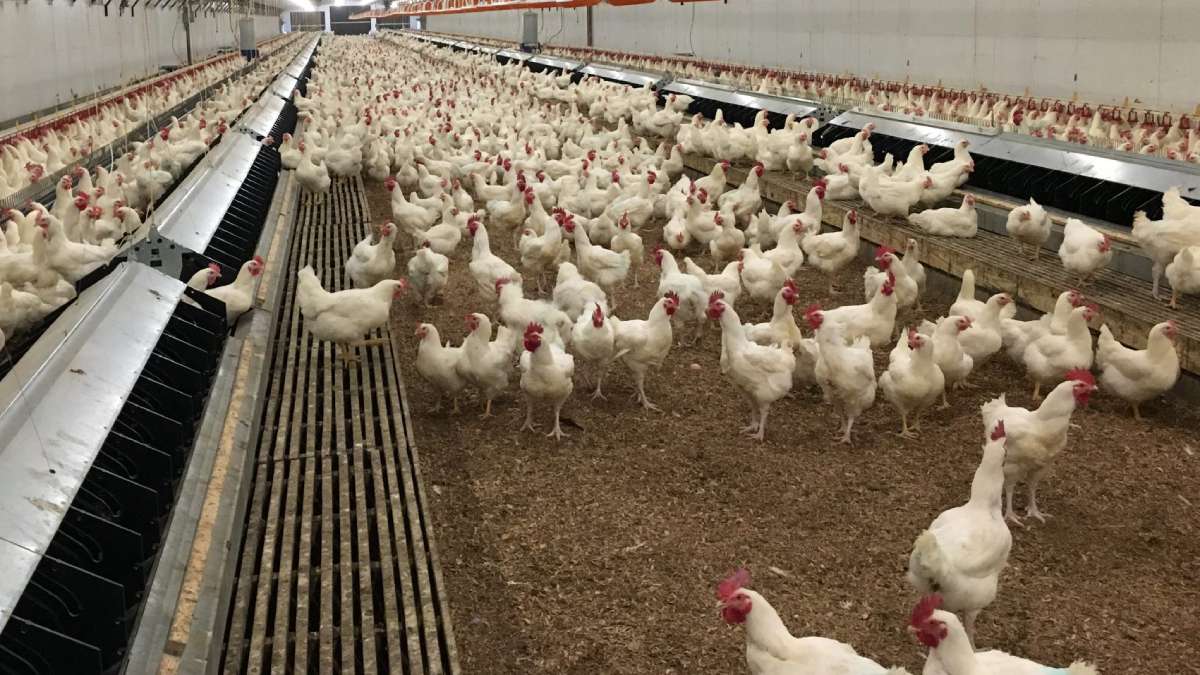
Эффективное освещение курятника — один из важнейших факторов для современных птицеводческих ферм. Независимо от того, выращиваете ли вы кур-несушек для производства яиц или бройлеров на мясо , правильное управление освещением влияет на рост, конверсию корма, реакцию на стресс и общую продуктивность.
В отличие от людей, куры видят более широкий спектр света, включая ультрафиолет, а это значит, что освещение должно быть адаптировано к их биологическим потребностям.
В этом руководстве мы объясним, как различные цвета освещения влияют на поведение и производительность птицы, опишем практические программы освещения для несушек и бройлеров, а также покажем, как такие инструменты, как таймеры и спектрометры, помогают фермерам добиваться стабильных и прибыльных результатов.
Каталог:
1. Почему освещение курятника имеет значение?
2. Основы куриного зрения и светового спектра
3. Как разные цвета освещения влияют на продуктивность птицы?
4. Освещение курятников для бройлеров (мясных кур)
5. Освещение курятника для производства яиц (несушек)
6. Как тестировать, контролировать и совершенствовать системы освещения для птицеводства?
7. Заключение: Долгосрочная ценность освещения курятника
1. Почему освещение курятника имеет значение?
Для домашней птицы свет — это не просто видимость. Он контролирует циклы питания, роста и яйцекладки. Птицам необходим постоянный свет для регулирования биологических часов, что, в свою очередь, влияет на продуктивность.
Для бройлеров правильные программы освещения способствуют равномерному потреблению корма и сбалансированному набору веса. Для несушек правильная продолжительность освещения и спектр напрямую влияют на размер яиц, качество скорлупы и стабильность яйценоскости. Без контролируемого светодиодного освещения в птичниках фермы часто сталкиваются с неравномерным ростом, стрессовым поведением и снижением эффективности.
Не менее важно и то, что освещение помогает поддерживать порядок в больших курятниках. Хорошо освещённая среда снижает агрессию, поддерживает активность кур в установленные часы и способствует общему благополучию. Хорошее освещение — это не просто расходы, а инвестиция в здоровье стада и производительность фермы.
Грамотно управляемое освещение закладывает основу для всех остальных аспектов птицеводства. Далее давайте разберёмся, как на самом деле видят куры и почему спектр важен.
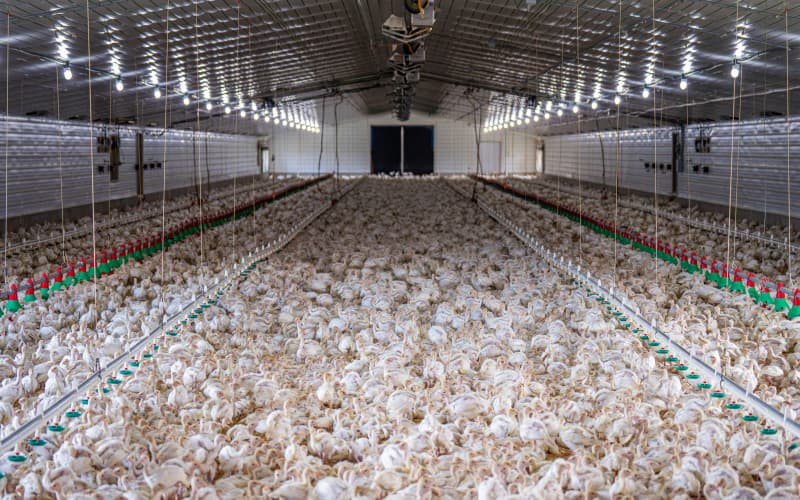
2. Основы куриного зрения и светового спектра
Здесь мы узнаем кое-что о науке освещения птиц . Куры воспринимают свет иначе, чем люди. Их глаза улавливают спектр 300–700 нм , охватывающий ультрафиолетовый, синий, зелёный и красный цвета . Этот более широкий диапазон даёт им возможность видеть гораздо дальше нашего предела в 380–750 нм.
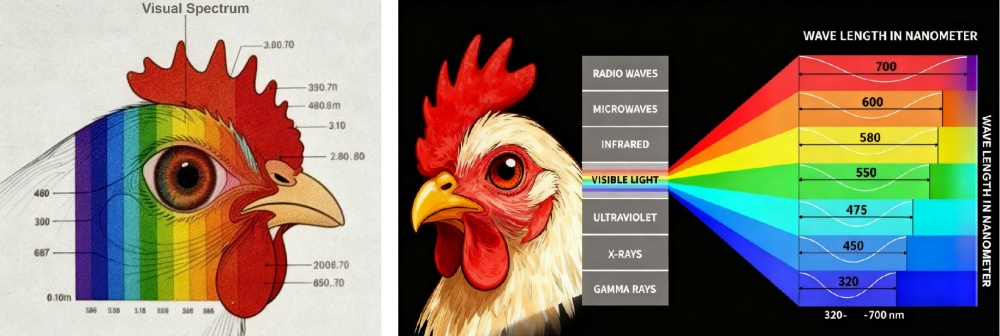
Their retina contains four cone types—each tuned to UV, blue, green, and red—plus double cones that enhance motion and brightness detection. This structure allows chickens to assess food freshness, notice parasites, and even sense flock health.
Because of this, light spectrum, not just brightness, strongly shapes poultry behavior and productivity. Understanding this vision system is the foundation for designing effective chicken coop lighting programs.
3. How Different Light Colors Affect Poultry Performance?
Modern chicken coop lights are more than just illumination. Different wavelengths directly affect poultry growth, stress levels, reproduction, and egg quality. Understanding these effects helps farms select the right spectrum for their production goals.
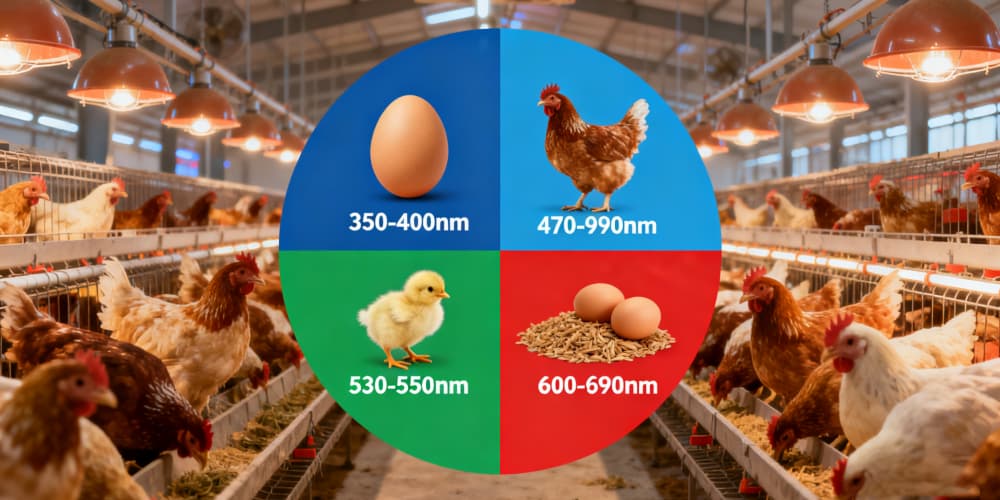
(1) Ultraviolet (UV, 350–400 nm)
Key benefit: Enhances vitamin D3 synthesis → better calcium absorption.
Result: Stronger eggshells, up to 0.05 mm thicker; soft-shell rate reduced below 0.5%.
Best use: 1 hour of UV exposure daily for laying hens.
(2) Blue Light (480–490 nm)
Key benefit: Lowers stress hormones, calms broilers.
Result: Escape attempts during handling reduced by 70%; meat tenderness improved.
Best use: Last 3 days before slaughter to keep birds calmer.
(3) Green Light (530–550 nm)
Key benefit: Stimulates muscle and bone growth in chicks.
Result: Leg bone length increased by 8%, growth rate up by 12%.
Best use: First 2 weeks of broiler rearing with 18h/day green-dominant light.
(4) Red Light (660–680 nm)
Key benefit: Stimulates feed intake and reproduction.
Result: 20% higher feed intake; fertilization rates up to 92%.
Best use: Breeding and laying periods to maximize productivity.
Light Spectrum and Poultry Performance
| Light Color | Wavelength (nm) | Main Effect | Practical Outcome | Best Use Stage |
|---|---|---|---|---|
| UV | 350–400 | Vitamin D3 synthesis, calcium absorption | Thicker shells, fewer soft eggs | Laying hens |
| Blue | 480–490 | Stress reduction | Calmer handling, better meat quality | Pre-slaughter |
| Green | 530–550 | Muscle and bone growth | Faster weight gain, stronger legs | Broiler chicks |
| Red | 660–680 | Feed intake, reproduction | More feed, higher fertility | Breeders & layers |
In short: Strategic use of color-specific chicken coop lights ensures healthier flocks, stronger eggs, and higher yields. Next, we'll see how these principles apply to broilers in practice.
4. Chicken Coop Lighting for Broilers (Meat Chickens)
Broiler lighting must follow two clear stages: brooding (0–2 weeks) and grower/finisher (≥3 weeks to market). Stage-specific spectrum, intensity and cycles drive feed intake, uniformity and final weight.
Spectrum. Use the blue–green range (≈415–560 nm) during both stages to promote growth and feed conversion; fast-growing white strains often benefit from a higher blue ratio (≈480–500 nm).
(1) Intensity & uniformity
Brooding (first week): bright start is critical — 20–30 lux (or ~30 lux at placement) to stimulate feeding and navigation. Keep brightness differences small; aim Uo ≥ 0.5 (min/max) and U₁ ≥ 0.7 (min/avg) to avoid crowding and feed-fight zones.
Growing → finishing: progressively reduce to 10–20 lux (grower) then 5–10 lux (finisher) to lower activity and improve feed efficiency.
(2) Flicker & stability
Use flicker-free LED drivers and high-frequency ballasts; minimize perceptible flicker for birds (recommended practical target: high frequency to avoid physiological effects.
(3) Photoperiod strategy
Start with 23 h light : 1 h dark at placement to encourage feeding and acclimation. From day 4–14, reduce photoperiod gradually toward ~18 h; in finishing, intermittent programs (e.g., cycles of 1 h light : 3 h dark) are proven options to maintain performance while saving energy.
Quick reference — Broiler lighting (practical)
| Stage | Age | Spectrum | Intensity (lux) | Typical cycle |
|---|---|---|---|---|
| Brooding | 0–7 days | 415–560 nm (blue/green) | 20–30 | 23L : 1D (first days) |
| Early grower | 8–21 days | 415–560 nm | 10–20 | Gradually shorten to 16–18 h light. |
| Finisher | 22 days → market | 415–560 nm (more green) | 5–10 | Intermittent options (e.g., 1L:3D cycles) for calm birds & feed conversion. |
5. Chicken Coop Lighting for Egg Production (Layers)
Unlike broilers, which focus on fast weight gain, layers depend on carefully controlled lighting to optimize egg production, shell strength, and laying cycles. Poor light management can delay sexual maturity or reduce overall egg yield.
5.1 Light Spectrum for Layers
Red–Orange Light (600–700 nm): Stimulates the hypothalamus, promoting sexual maturity and ovulation.
Warm White (similar spectrum 2700–3500K): Often used in commercial layer houses to encourage consistent egg laying.
Avoid excessive blue/green dominance: While calming, these can delay laying onset if used alone.
Key Point: Layers need more red light stimulation compared to broilers, as reproduction is the main goal.
5.2 Recommended Light Intensity
Pullet rearing (0–16 weeks): 10–15 lux is enough; excessive brightness causes nervousness and feather pecking.
Laying period (>16 weeks): 10–30 lux ensures hens can see feed, water, and nesting boxes clearly.
Nest area: Slightly dimmer (<10 lux) encourages hens to use nest boxes instead of floor-laying.
5.3 Light Cycle Control
Layers respond strongly to day length. A correct schedule initiates laying at the right age and sustains peak production.
| Stage | Age (weeks) | Photoperiod (h) | Intensity (lux) | Notes |
| Brooding (0–6w) | 0–6 | 20–23L | 10–15 | Long light to stimulate feeding and growth |
| Growing (7–16w) | 7–16 | 8–10L | 10–15 | Short days prevent premature sexual maturity |
| Pre-Lay (17–18w) | 17–18 | 12–14L | 10–20 | Gradual increase prepares hens for laying |
| Laying (>19w) | 19+ | 14–16L | 15–30 | Maintain stable long days to sustain egg yield |
In summary:
Chicken coop lighting for egg production should be red-dominant, stable, and uniform with careful control of day length. A smooth transition from rearing to laying cycles helps prevent early maturity, improves egg shell quality, and maximizes long-term productivity.
6. How to Test, Control, and Improve Poultry Lighting Systems?
Poultry lighting only delivers results when it is measured, adjusted, and tracked. Poultry farms benefit from using the right tools and a consistent management routine.
6.1 Measuring Light Intensity
Lux meters with at least ±5% accuracy are essential.
During brooding, check illuminance at the drinkers and feed trays (20–30 lux recommended).
In the growing and laying phases, measure directly above feed troughs (5–20 lux depending on stage).
Take readings at multiple points to ensure uniformity (Uo ≥0.5) across the house.
6.2 Managing Light Spectrum
Different bulbs deliver different results:
Standard LED white light: balanced red, green, blue spectrum but no UV.
Special UV lamps (350–400 nm, ≥80% UV share): improve calcium metabolism and eggshell quality.
Blue-spectrum tubes (480–490 nm, ≥90% blue share): useful in broiler houses to reduce stress and improve feed conversion.
Best practice: Combine general white LED lighting with targeted spectrum lamps for specific outcomes.
6.3 Timers and Automation
Programmable timers avoid sudden switches on/off that stress birds. Gradual dimming is recommended.
Cycle control: For broilers, use intermittent cycles (e.g., 1h light + 3h dark) in finishing stages. For layers, ensure stable 14–16 hours daily once laying begins.
Central controllers or mobile apps allow precise scheduling across multiple houses, reducing labor.
6.4 Оценка эффективности освещения
Освещение не является самоцелью — результаты работы фермы должны подтверждать успех .
Бройлеры: отслеживайте ежедневный прирост веса, коэффициент конверсии корма (FCR), время вывода на рынок и качество тушки.
Несушки: отслеживайте скорость яйценоскости, средний вес яиц, толщину скорлупы и процент яиц с мягкой скорлупой.
Поведенческие сигналы: неравномерное скопление яиц, расклев перьев или кладка яиц на полу могут быть признаком плохой равномерности освещения.
Вкратце: систематическое тестирование, управление спектром и автоматизированное планирование превращают освещение курятников в полноценный инструмент производства. Сочетая измерения с отслеживанием результатов , фермеры гарантируют, что инвестиции в освещение приведут к повышению продуктивности и укреплению здоровья стад.
7. Заключение: Долгосрочная ценность освещения курятника
Освещение курятника — это больше, чем просто освещение: оно напрямую влияет на рост, здоровье и продуктивность птицы. Правильный спектр, интенсивность и управление световым циклом улучшают конверсию корма у бройлеров, а также качество скорлупы яиц и яйценоскость у несушек.
Использование правильных инструментов, таймеров и методов измерения обеспечивает постоянное, равномерное освещение и минимальный стресс для птиц. Можно настраивать свет определённого спектра, например, ультрафиолетовый, синий, зелёный и красный, для достижения точных результатов: от укрепления костей до более спокойного поведения.
Автоматизация и тщательный мониторинг помогают фермам поддерживать стабильную освещенность , учитывая сезонные изменения и различия между породами. Связывая управление освещением с отслеживанием показателей — набора веса, конверсии корма (FCR), производства яиц и качества скорлупы — фермеры могут оптимизировать как эффективность, так и благополучие животных.
Короче говоря, светодиодное освещение для курятника — это стратегическая инвестиция. При правильном внедрении оно способствует укреплению здоровья поголовья, повышению продуктивности и долгосрочной рентабельности фермы.
Сопутствующий продукт
Светодиодный светильник для курятника T5

Светодиодная лампа для курятника D80
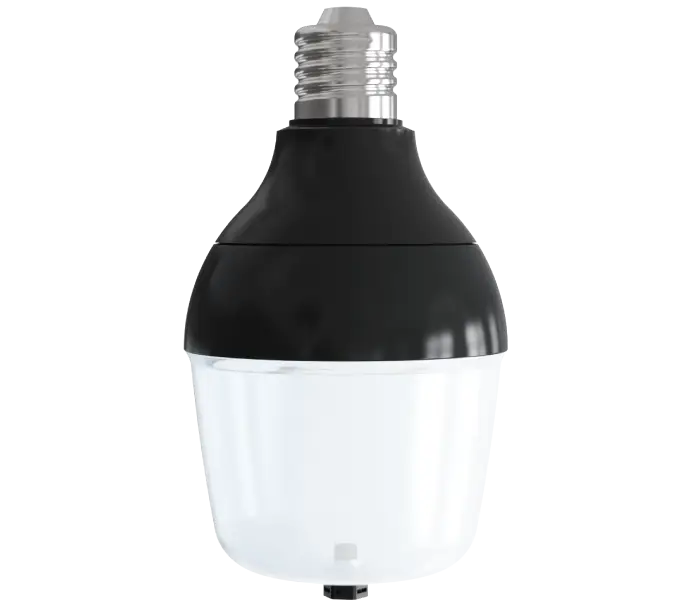
_thumb.jpg)
